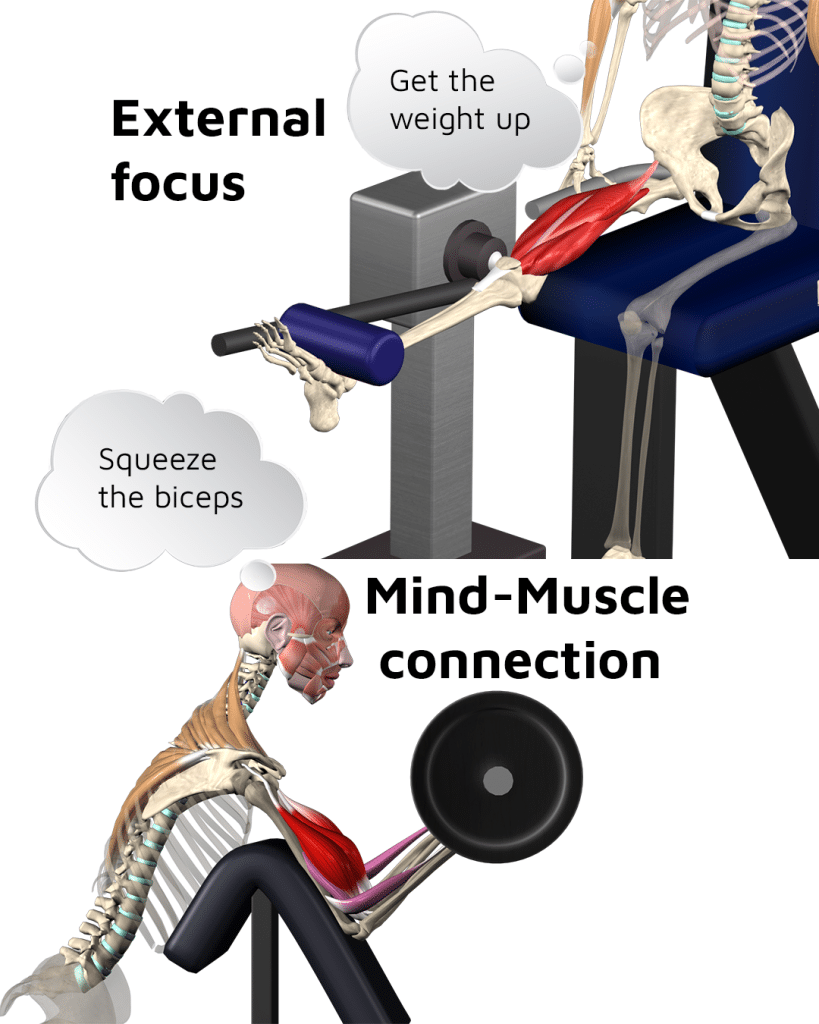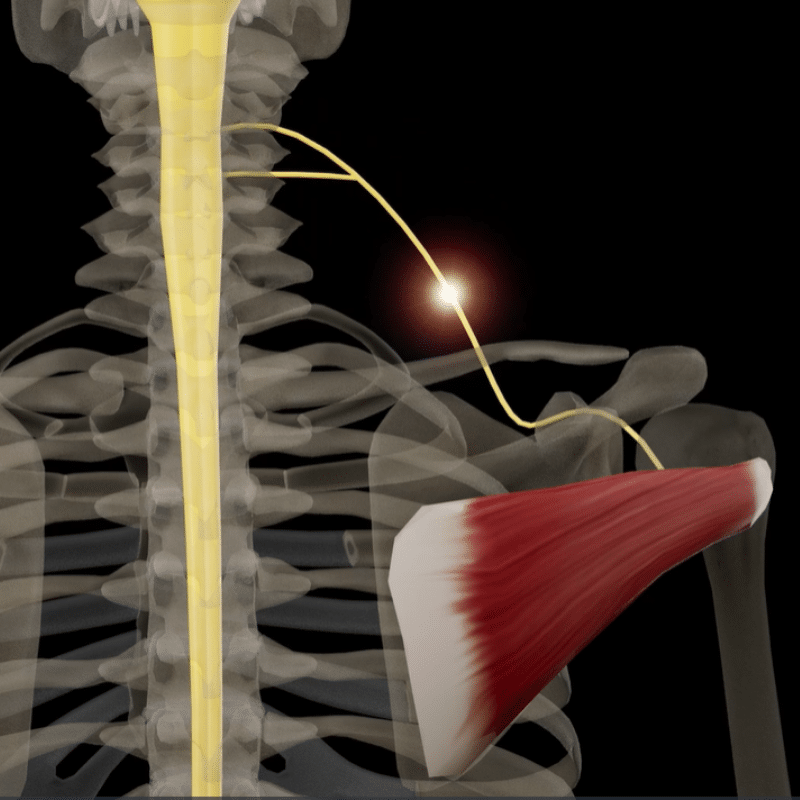The mind-muscle connection refers to the conscious effort to focus one’s attention on the contraction of a specific muscle or muscle group during exercise.
This practice involves mentally engaging with the working muscle, aiming to isolate and enhance its activation without relying solely on the movement’s mechanical execution. Using this focus, individuals can potentially achieve more significant muscle growth.
In this Muscle and Motion article, we delve into the literature surrounding the concept of the mind-muscle connection. We will explain how to implement this strategy into your fitness routine and discuss the benefits of it.
Join us as we explore actionable tips and exercises designed to strengthen this connection and uncover the advantages it offers to your training regimen.
The science behind the mind-muscle connection
In 2016, Calatayud et al. conducted a study published in the European Journal of Applied Physiology that shed light on the importance of the mind-muscle connection during progressive resistance training. This study involved 18 men experienced in resistance training who performed bench press exercises under different scenarios.
The purpose was to explore whether intentionally focusing on specific muscles would result in their targeted activation.[1] The findings revealed that participants could increase muscle activity in the triceps brachii or pectoralis major by focusing on these muscles during the exercise, particularly at intensities up to 60% of their one-repetition maximum (1RM). Interestingly, a threshold appeared to exist between 60% and 80% of 1RM, beyond which the selective activation of these muscles was not as effective. This study underscores the potential of mental focus in enhancing muscle activation and, by extension, the effectiveness of resistance training.
In 2018, Brad Jon Schoenfeld et al. conducted a study published in the European Journal of Sport Science that explored how mental focus affects muscle development in resistance training. The study included 30 untrained men divided into two groups: one focused internally on muscle contractions (mind-muscle connection group) and the other focused externally on the lifting movements (external group).[2]
The study’s significant findings revealed that the mind-muscle connection group experienced a more substantial increase in muscle thickness (hypertrophy) in their elbow flexors (12.4%) compared to the external group (6.9%). However, both groups showed similar results in the growth of quadriceps muscles, with no significant difference between them.
The researchers propose that this might be due to individuals generally having better control over their upper body muscles than their lower body muscles, indicating a variance in muscle control precision between the two areas. This research underscores the effectiveness of the mind-muscle connection in developing the elbow flexor muscles. It suggests that focusing on the muscles being worked can lead to more significant muscle growth in the upper body.

Characteristics of mind-muscle connection
- Increased muscle excitation: Mind-muscle connection can lead to higher muscle excitation when working at up to 60% of one’s one-repetition maximum (1RM).[1]
- Enhanced upper limb muscle growth: By concentrating on the contraction of the muscles being worked, particularly in the upper body, individuals can see significant improvements in muscle growth. This method ensures that the targeted muscles are fully activated and engaged, promoting better development.[2]
- Reduced risk of injury: Injury often happens during sudden, powerful movements, such as sprinting, lunging, or jumping, which can overstretch your tendons or muscles. The risk of such injuries can be lowered by emphasizing the mind-muscle connection. Shifting the focus from merely lifting heavy weights to a more conscious engagement and contraction of muscles promotes improved form and control.
- Considerations for novice lifters: Research indicates that the mind-muscle connection might not enhance performance or muscle activation for beginners. Novice lifters, who are still learning exercises or adapting to new weights, may find using advanced cues for mind-muscle connection distracting.[3,4]
Incorporating mind-muscle connection into your training
Now that we have explored the scientific principles of the mind-muscle connection and its benefits and potential drawbacks, let’s delve into how you can more effectively integrate this concept into your training regimen. This approach goes beyond merely focusing on contracting a specific muscle in a certain exercise.
How to improve your mind-muscle connection
- Slow down your reps: Slowing down the movement allows you to focus more on the muscle being targeted, enhancing the connection.
- Employ mental visualization: Prior to initiating your exercise set, take a moment to mentally envision the targeted muscle going through its contraction and relaxation phases. Mental visualization can significantly sharpen your focus on the muscle’s activity. Our app, which includes graphics designed to illustrate muscle function, can be a valuable tool in this process, allowing you to see exactly how each muscle engages during an exercise.
- Use lighter weights: Begin your exercises with lighter weights. This strategy emphasizes muscle contraction and engagement over the challenge of lifting heavier loads, facilitating a stronger mind-muscle link.
- Minimize distractions: Implement strategies such as listening to music or wearing noise-canceling headphones to maintain a deep, inward focus on your muscle activity. Eliminating external distractions ensures that your attention remains on the muscle contracting.
In conclusion, the mind-muscle connection presents a nuanced approach to training, suggesting potential benefits such as muscle growth and a reduced risk of injury. However, it’s important to approach this technique with a balanced perspective, especially considering its varying effectiveness among different individuals.
Strategies like slowing down repetitions, employing mental visualization, using lighter weights, and minimizing distractions can indeed help in fostering this connection. Yet, the extent of its impact may differ based on one’s training level and familiarity with the exercises. As such, while the mind-muscle connection can be a valuable component of a comprehensive training regimen, it should be integrated thoughtfully, with an awareness of its limitations and considering personal training goals and experience.
If you want to learn more about the effect of the mind-muscle connection on strength and athletic performance, check out our article regarding this topic.
In addition to the strategies mentioned above, our Strength Training App enhances your ability to forge stronger mind-muscle connections, thanks to its detailed 3D animations of muscle work during exercises.
The Strength Training App enables you to ‘look beneath the skin’ at the active muscles in any exercise. This immediate visual feedback is crucial for directing your focus toward the muscles you intend to work on, thereby simplifying the process of developing and sustaining the mind-muscle connection.
Ever wondered what makes our anatomical animations so accurate and engaging? Click here to learn about our Quality Commitment and the experts behind our content.
At Muscle and Motion, we believe that knowledge is power, and understanding the ‘why’ behind any exercise is essential for your long-term success.
Let the Strength Training App help you achieve your goals! Sign up for free.
Reference:
- Calatayud, J., Vinstrup, J., Jakobsen, M. D., Sundstrup, E., Brandt, M., Jay, K., Colado, J. C., & Andersen, L. L. (2016). Importance of mind-muscle connection during progressive resistance training. European Journal of Applied Physiology, 116(3), 527–533.
- Schoenfeld, Brad Jon, Vigotsky, A., Contreras, B., Golden, S., Alto, A., Larson, R., Winkelman, N., & Paoli, A. (2018). Differential effects of attentional focus strategies during long-term resistance training. European Journal of Sport Science: EJSS: Official Journal of the European College of Sport Science, 18(5), 705–712.
- Wulf, G. (2013). Attentional focus and motor learning: a review of 15 years. International Review of Sport and Exercise Psychology, 6(1), 77–104.
- Fujita, R. A., Silva, N. R. S., Bedo, B. L. S., Santiago, P. R. P., Gentil, P. R. V., & Gomes, M. M. (2020). Mind–muscle connection: Limited effect of verbal instructions on muscle activity in a seated row exercise. Perceptual and Motor Skills, 127(5), 925–938.


